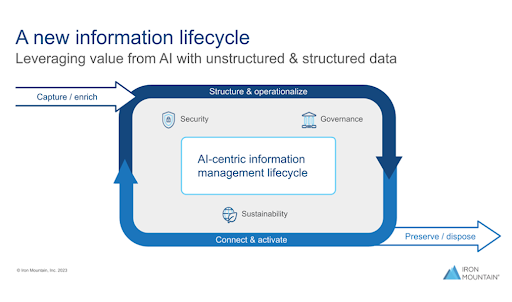Advancing AI: The emergence of a modern information lifecycle
I appreciate the zen that envelops me when I get lost in a good puzzle. But, truth be told, that “zen” doesn’t happen until I’m attuned to the puzzle’s colors, shapes, and patterns.

I appreciate the zen that envelops me when I get lost in a good puzzle. But, truth be told, that “zen” doesn’t happen until I’m attuned to the puzzle’s colors, shapes, and patterns. Once I am, the border falls into place, colors get grouped, and images form—and I eventually become familiar with the intricate details and shapes of the remaining pieces.
Although less complex than the “4 Vs” of big data (velocity, veracity, volume, and variety), orienting to the variety and volume of a challenging puzzle is similar to what CIOs face with information management.
As data skyrockets—especially unstructured data—organizations need an intentional plan and ongoing approach to protect, manage, and optimize data for monetization. Once focused solely on reducing search and retrieval times, information lifecycle management (ILM) is now critical to workflow automation, identifying and tracking performance metrics, and harnessing the burgeoning potential of AI.
Operationalizing data to drive revenue
CIOs report that their roles are rising in importance and impact. The vast majority (85%) of CIOs say they are becoming organizational changemakers. And 68% of CIOs state that creating revenue-generating initiatives is now among their job responsibilities. What’s changed?
It’s now clear that CIOs hold the keys to unlocking the untapped value of data—and all assets—and by doing so, can catalyze a “make-or-break” business advantage. CIOs can best navigate by understanding and embracing the modern information lifecycle that is emerging from the chaos of the digital age.
Tomorrow’s market leaders will recognize how to curate and enrich the value of all assets, which will train AI models, generate insights, and drive automation. CIOs must recognize this paradigm so that all relevant, timely, and accurate data trapped in physical objects and formats is proactively identified, enriched, operationalized, and accessible to AI-driven automation, generative AI, and immersive experiences.
Changing this paradigm means re-evaluating the generally linear and static information lifecycle of old, which is, roughly, “create, store, use, share, archive or destroy.” In contrast, the new lifecycle is distinctly digital, agile, and recursive. When you enrich, structure, and operationalize data on the way in, there is no limit to the efficiencies, value streams, and insights unlocked by readily available powerful cloud platform tools.
A modern information lifecycle management approach
Today’s ILM approach recognizes the enterprise value of all digitized and enriched assets, avoiding the habituated, narrow reliance ontraditional structured data. The ways modern data is used, processed, and analyzed are continuously evolving as machine learning technology becomes better at these tasks. With constant advances in intelligent document processing (IDP), compute power, DevOps workflows, and AI, the content, context, and value of unstructured data is rapidly increasing.
A modern information lifecycle management approach helps CIOs and their teams align processes to business objectives and regulatory requirements. And it does so while accommodating the increasing emphasis on security, governance, and environmental sustainability. Here is a high-level overview of the ILM steps and structure.
Image

Iron Mountain
- Capture/Enrich: Beyond “records,” organizations can digitally capture anything and apply metadata for context and searchability.
- Structure/Operationalize: Once an asset has been enriched by distinctly identifying and labeling its attributes, organizationsmust store it for optimal accessibility and functionality. For example, a purpose-built content services platform and well-architected data lake can provide easy access for automation and AI use.
- Connect/Activate: When data is stored in a modern, accessible repository, organizations gain newfound capabilities. They can pull data from multiple sources and connect it to create customized “views,” robust automations, and to train and feed AI models, catalyzing a virtuous cycle of monetization.
- Preserve/Dispose: Original data formats that no longer need to be stored can be destroyed in accordance with regulatory and organization policies, reducing the costs and risks of keeping them in storage while minimizing environmental impact.
Throughout the information lifecycle, the three tenets of security, governance, and sustainability are a zero-compromise, integral part of the process.
Supporting business outcomes
Using a strategic approach to information lifecycle management, CIOs can leverage the full value of rich and untapped assets while accelerating AI and automation capabilities.
In my role at Iron Mountain, I work with leaders across 65 countries to establish unified information lifecycle management strategies. I’ve seen the transformational results that are possible, making me a passionate advocate. Outside of Iron Mountain, you will likely find me enjoying the relative simplicity of a 1000-piece puzzle.
Learn more about how organizations can activate a modern information lifecycle management approach with the help of a unified asset strategy.









